Dabur India Bundle
Who Really Owns Dabur India?
The ownership structure of a company is a critical factor, influencing its strategic direction and market performance. Dabur India Limited, a titan in the Indian FMCG sector, offers a fascinating case study. Founded in 1884, Dabur's journey from Ayurvedic medicine to a diversified consumer goods giant is a testament to its enduring vision.
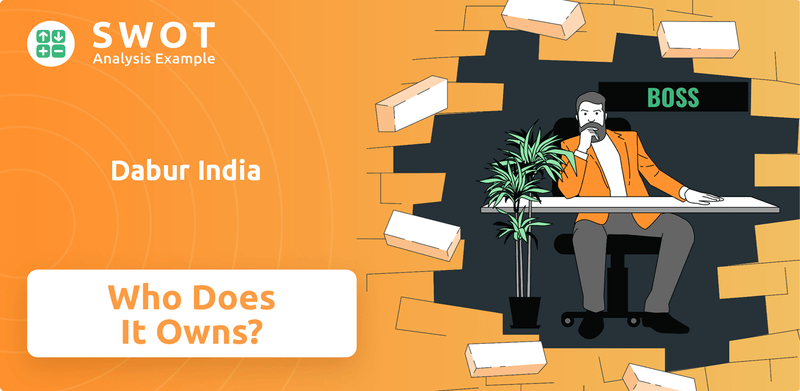
Understanding Dabur India SWOT Analysis and its ownership is paramount for investors and business strategists alike. This exploration into Dabur's ownership structure will uncover the evolution of its shareholding, from the founding family to current major shareholders, offering insights into the company's governance and future trajectory. Discover the individuals and entities that shape the Dabur company, examining the roles of Dabur promoters and key executives in driving its success and financial performance. This deep dive into Dabur ownership will also examine the Dabur India company structure, including its market capitalization and the influence of its board of directors, and the impact of its shareholding pattern.
Who Founded Dabur India?
The story of Dabur India begins with Dr. S.K. Burman, who founded the company in 1884. As the sole founder, Dr. Burman initially held complete ownership of the company. His vision was to blend Ayurvedic principles with modern science, creating effective health remedies. This early structure was a proprietary concern, with all control and equity resting solely with Dr. Burman.
During its early years, Dabur operated as a family-owned entity. Dr. Burman, and later his descendants, directly managed decisions regarding expansion, product development, and distribution. Because the company was initially private, the exact shareholding percentages from those early years are not publicly available. However, control remained firmly within the Burman family. There are no recorded early ownership disputes or buyouts during this foundational period, as the family's shared vision guided the company's development.
This singular focus on the founder's vision shaped the initial distribution of control, ensuring that the company's core mission remained paramount. The company's early success was built on Dr. Burman's personal investment and expertise, laying the groundwork for what would become a major player in the Indian consumer market.
Dr. S.K. Burman's vision combined Ayurvedic knowledge with modern science. This approach set the foundation for Dabur's product development. His focus on quality and efficacy drove early success.
The company's early operations were entirely family-run. Decisions were made directly by the founder and his descendants. This ensured a consistent approach to business.
Initially, Dabur was a proprietary concern. This meant that Dr. Burman held all equity and control. There were no external investors in the beginning.
All equity and control were vested in Dr. Burman. This structure allowed for rapid decision-making. It also ensured alignment with the founder's vision.
Dabur's early growth was organic, driven by the founder's expertise. The focus was on building a strong brand reputation. This approach laid the foundation for future expansion.
The founder's vision guided the company's mission. This focus on Ayurvedic healthcare was central. It shaped the initial distribution of control.
Understanding Dabur's early ownership provides context. The Burman family's control was pivotal to its growth. This shaped the company's culture and strategic direction.
- The founder's vision was the driving force.
- Family ownership ensured consistent values.
- Early control was solely with Dr. Burman.
- The focus was on Ayurvedic healthcare.
Dabur India SWOT Analysis
- Complete SWOT Breakdown
- Fully Customizable
- Editable in Excel & Word
- Professional Formatting
- Investor-Ready Format
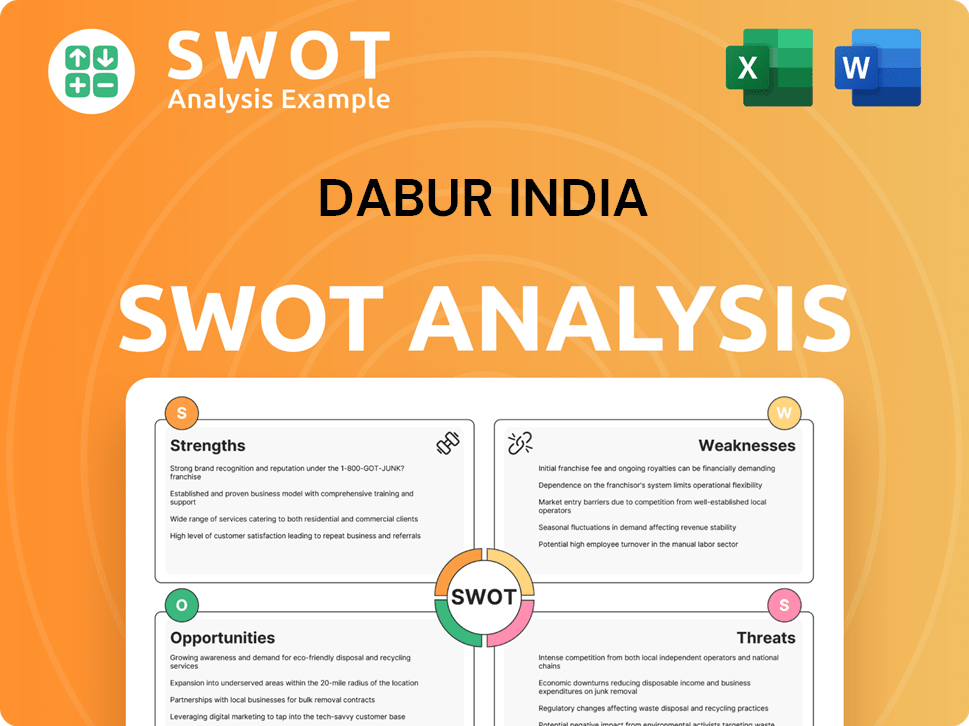
How Has Dabur India’s Ownership Changed Over Time?
The evolution of Dabur India from a private, family-owned enterprise to a publicly listed company is a key aspect of understanding its ownership. The company's Initial Public Offering (IPO) in 1994 was a pivotal moment, opening the door to public shareholders and diversifying its ownership beyond the founding family. This transition marked a significant shift in the company's structure, allowing for broader participation from institutional and individual investors.
The IPO in 1994 allowed for wider investor participation. While specific initial market capitalization figures from the 1994 IPO are not readily available in recent updates, this event allowed for broader participation from institutional and individual investors.
| Shareholder Category | Shareholding as of December 31, 2024 | Shareholding as of March 31, 2024 |
|---|---|---|
| Promoter and Promoter Group | Approximately 66.24% | Data Not Available |
| Foreign Portfolio Investors (FPIs) | Data Not Available | 18.06% |
| Domestic Institutional Investors (DIIs) | Data Not Available | 8.91% |
As of early 2025, the Burman family, the original founders, continues to hold a substantial stake in Dabur India, maintaining significant control over the company's strategic direction. Their shareholding, though diluted over the years due to public offerings and market activities, remains the largest single block. Institutional investors, including mutual funds, foreign institutional investors (FIIs), and domestic institutional investors (DIIs), constitute another major segment of Dabur's ownership. These shifts in major shareholding, particularly the increasing presence of institutional investors, have subtly influenced the company's governance, pushing for greater transparency and adherence to global best practices while the Burman family maintains strategic oversight.
The ownership structure of the
- The Burman family's holdings are a significant influence on the company.
- Institutional investors, including FPIs and DIIs, also hold a large number of shares.
- The company's governance is influenced by the presence of institutional investors.
- The shareholding pattern shows a balance between promoter and public ownership.
Dabur India PESTLE Analysis
- Covers All 6 PESTLE Categories
- No Research Needed – Save Hours of Work
- Built by Experts, Trusted by Consultants
- Instant Download, Ready to Use
- 100% Editable, Fully Customizable
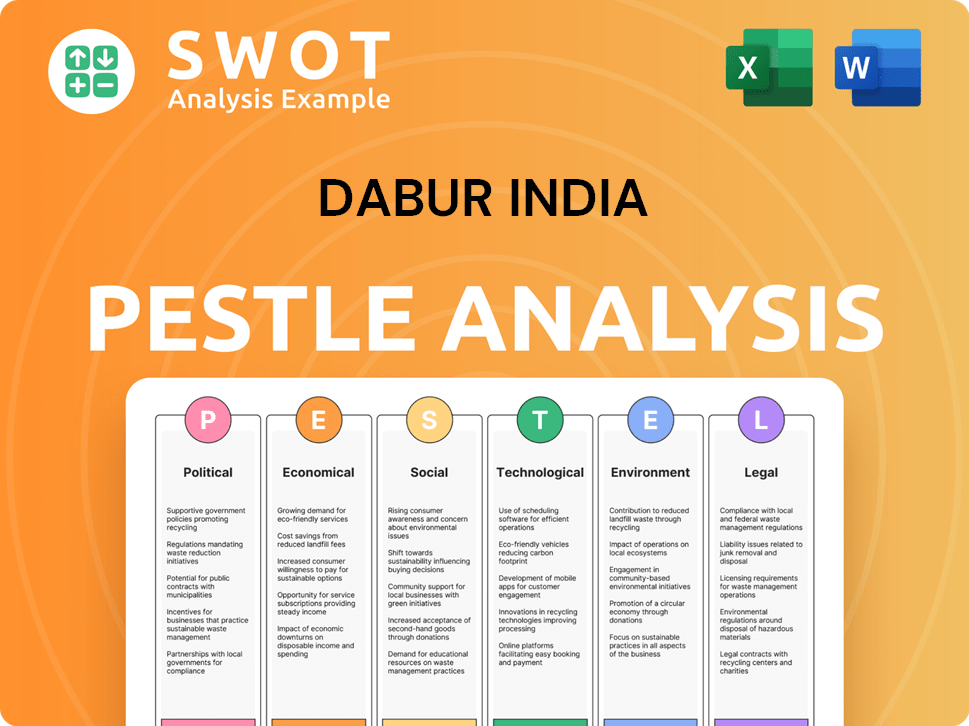
Who Sits on Dabur India’s Board?
The Board of Directors of Dabur India, as of early 2025, comprises a mix of family members, independent directors, and representatives of major shareholders. This structure aims to balance the company's heritage with modern corporate governance practices. Key figures from the Burman family, such as Mohit Burman as Non-Executive Chairman and Amit Burman as Non-Executive Vice Chairman, hold prominent positions, reflecting their ongoing influence. Independent directors are also integral, providing unbiased oversight and ensuring regulatory compliance. This composition helps maintain a balance between family involvement and external perspectives.
The presence of both family members and independent directors on the board is crucial for strategic decision-making. The Burman family’s long-standing involvement ensures continuity and a deep understanding of the company's history and values. Independent directors bring diverse expertise and perspectives, which are essential for navigating the complexities of the market and ensuring that the interests of all shareholders are considered. This setup supports sound corporate governance and helps maintain the company's reputation and financial health. The board's composition is designed to adapt to market changes while upholding Dabur's core principles.
| Director | Position | Details |
|---|---|---|
| Mohit Burman | Non-Executive Chairman | Member of the Burman family, significant influence. |
| Amit Burman | Non-Executive Vice Chairman | Member of the Burman family, key leadership role. |
| Independent Directors | Various | Provide unbiased perspectives and ensure regulatory compliance. |
Dabur operates under a one-share-one-vote system, which means that each share of equity has equal voting rights. This structure allows the Burman family, as major shareholders, to wield substantial voting power, influencing strategic decisions and corporate actions. There are no reports of dual-class shares or special voting rights that would grant disproportionate control to any specific entity beyond their equity stake. The company's governance structure ensures that while the founding family maintains considerable influence, the decision-making process is also subject to the scrutiny of public and institutional investors. This balance is crucial for maintaining investor confidence and ensuring accountability.
The Burman family's significant shareholding translates into substantial voting power, influencing strategic decisions. Dabur's board includes family members and independent directors, ensuring a balance of perspectives. The company follows a one-share-one-vote system, ensuring fair voting rights for all shareholders.
- The Burman family holds key positions, reflecting their influence.
- Independent directors provide unbiased oversight and ensure compliance.
- The voting structure ensures that the Burman family's stake translates to influence.
- The board structure supports sound corporate governance.
Dabur India Business Model Canvas
- Complete 9-Block Business Model Canvas
- Effortlessly Communicate Your Business Strategy
- Investor-Ready BMC Format
- 100% Editable and Customizable
- Clear and Structured Layout
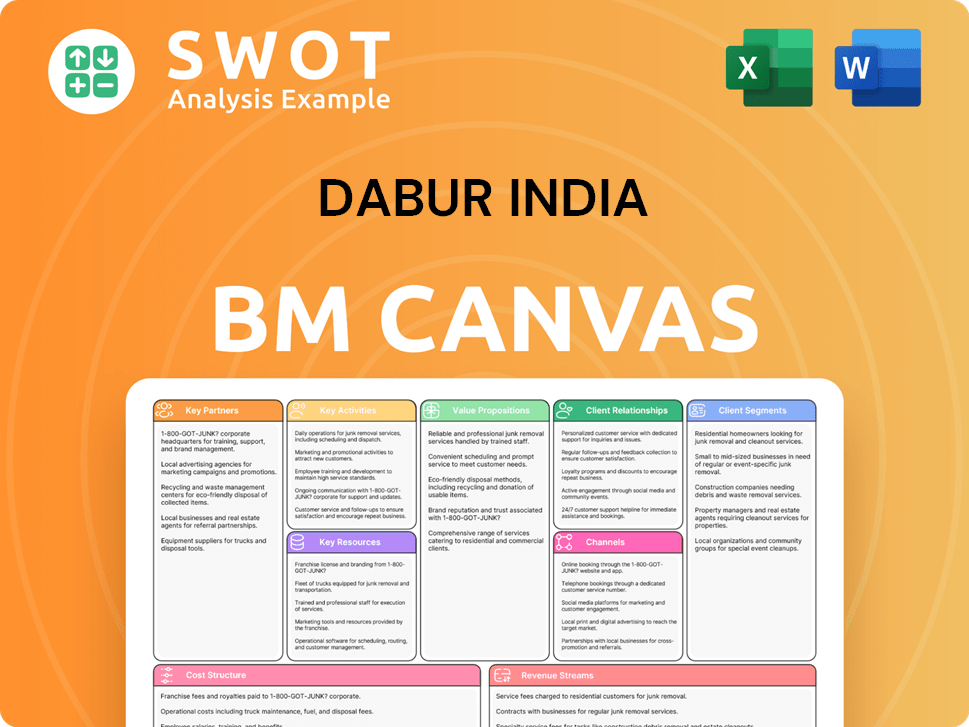
What Recent Changes Have Shaped Dabur India’s Ownership Landscape?
Over the past few years, the ownership structure of Dabur India has remained relatively stable. The Burman family continues to hold a significant promoter stake, maintaining their influence over the Dabur company. While there haven't been major shifts in ownership percentages through buybacks or secondary offerings, the focus has been on strategic acquisitions and organic growth. An example is the acquisition of a 51% stake in Badshah Masala in January 2023, demonstrating a strategic move to expand its business rather than a change in ownership.
Industry trends such as the growing influence of institutional investors and ESG considerations have subtly impacted Dabur's ownership. Institutional ownership has remained consistent, reflecting confidence in the company's long-term prospects. There are no public announcements regarding significant succession plans or potential privatization in the near future. The emphasis remains on sustainable growth and market leadership within its core categories, supported by the current stable ownership structure. For more insights, explore the Growth Strategy of Dabur India.
| Shareholder Category | Approximate Shareholding (as of recent filings) | Notes |
|---|---|---|
| Promoters | Around 68% | Burman family and related entities |
| Institutional Investors | Around 20-22% | Includes mutual funds, insurance companies, and foreign institutional investors |
| Public | Around 10-12% | Retail investors and others |
The Burman family's continued strong stake provides stability, while institutional investors show ongoing confidence. The company's focus remains on sustainable growth and market leadership.
Stable promoter holding by the Burman family. Consistent institutional investor interest. Focus on organic growth and strategic acquisitions. No major changes in ownership structure are expected in the near term.
Acquisition of Badshah Masala in 2023. Continued focus on expanding product portfolio. Emphasis on sustainable growth and market leadership. No significant share buybacks or secondary offerings.
The Burman family's long-term commitment provides stability. Institutional investors' consistent holdings indicate confidence. The current structure supports strategic initiatives and market growth.
Expectations of continued organic growth and strategic acquisitions. No major changes in ownership structure are anticipated. Focus on maintaining market leadership and shareholder value.
Dabur India Porter's Five Forces Analysis
- Covers All 5 Competitive Forces in Detail
- Structured for Consultants, Students, and Founders
- 100% Editable in Microsoft Word & Excel
- Instant Digital Download – Use Immediately
- Compatible with Mac & PC – Fully Unlocked
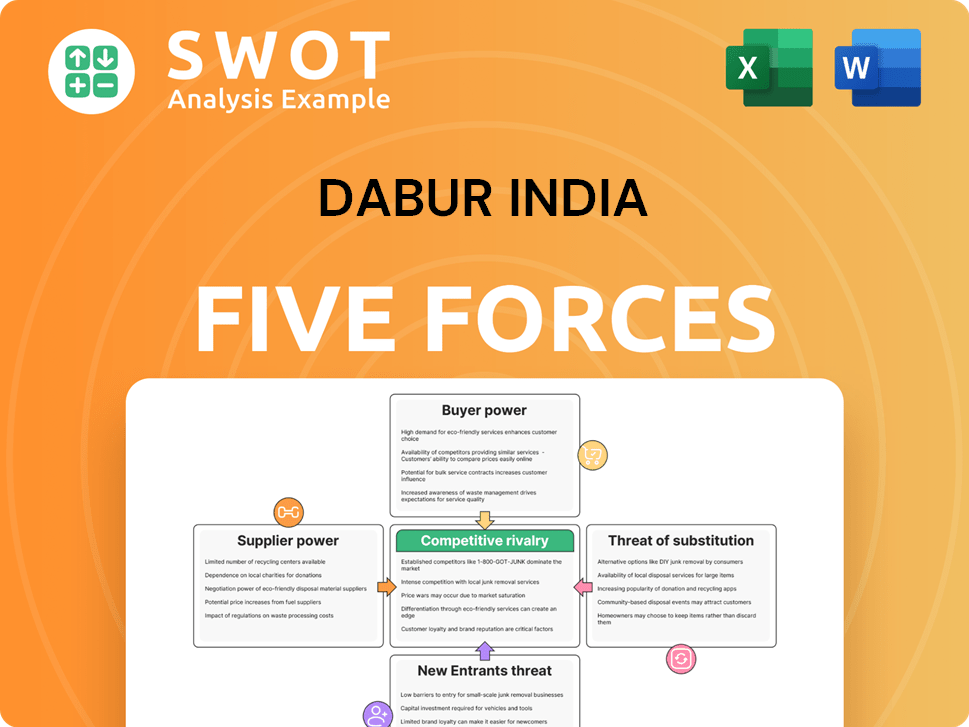
Related Blogs
- What are Mission Vision & Core Values of Dabur India Company?
- What is Competitive Landscape of Dabur India Company?
- What is Growth Strategy and Future Prospects of Dabur India Company?
- How Does Dabur India Company Work?
- What is Sales and Marketing Strategy of Dabur India Company?
- What is Brief History of Dabur India Company?
- What is Customer Demographics and Target Market of Dabur India Company?
Disclaimer
All information, articles, and product details provided on this website are for general informational and educational purposes only. We do not claim any ownership over, nor do we intend to infringe upon, any trademarks, copyrights, logos, brand names, or other intellectual property mentioned or depicted on this site. Such intellectual property remains the property of its respective owners, and any references here are made solely for identification or informational purposes, without implying any affiliation, endorsement, or partnership.
We make no representations or warranties, express or implied, regarding the accuracy, completeness, or suitability of any content or products presented. Nothing on this website should be construed as legal, tax, investment, financial, medical, or other professional advice. In addition, no part of this site—including articles or product references—constitutes a solicitation, recommendation, endorsement, advertisement, or offer to buy or sell any securities, franchises, or other financial instruments, particularly in jurisdictions where such activity would be unlawful.
All content is of a general nature and may not address the specific circumstances of any individual or entity. It is not a substitute for professional advice or services. Any actions you take based on the information provided here are strictly at your own risk. You accept full responsibility for any decisions or outcomes arising from your use of this website and agree to release us from any liability in connection with your use of, or reliance upon, the content or products found herein.